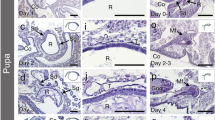Abstract
We investigated the morphology and ultrastructure of the cervical lobes of Apis mellifera drones with respect to age. The lobe epithelium decreases while the cuticle thickness increases as the drone gets older. Ultrastructural study revealed that the lobe has no secretory function but possibly acts as an inflatable bag during copulation.
Zusammenfassung
Auch wenn Drohnen meist nur eine geringe Beachtung bekommen, so ist ihre Rolle in der Bienengemeinschaft doch von essentieller Bedeutung, denn die Weitergabe ihres Spermas ist die Voraussetzung für Königinnen, als Nachkommen Arbeiterinnen zu erzeugen.
Während der Paarung stülpt der Drohn sein Begattungsorgan aus und führt es gleichzeitig in die Stachelkammer und in den medianen Eileiter der Königin ein. Das Begattungsorgan unterteilt sich in drei Hauptabschnitte, das Vestibulum mit den beiden Hörnchen, den Bulbus und die Cervix mit dem Federanhang.
Unter Anwendung von Licht-, Elektronen- und Rasterelektronenmikroskopie wurde der Federanhang in allen Einzelheiten untersucht. Die Abhängigkeit der Dicke des Epithels und der Kutikula vom Alter wurde gemessen. Das Epithel des Anhangs ist beim Schlupf sehr dünn. Während der sexuellen Reifung wird das Epithel noch dünner, während die Kutikula an Stärke zunimmt (Abb. 3). Das Lumen bleibt leer (Abb. 5C)
In der Ultrastruktur fanden wir Mitochondrien, aber keine sekretorischen Vesikel (Abb. 5D). Das extrem dünne Epithel, fehlende Sekretvesikel und das leere Lumen weist darauf hin, dass es sich hier nicht um ein Drüsenepithel handelt. Da Königin und Drohn während der Kopulation so fest wie „ein Korken mit der Flasche“ verbunden sind, könnte der Anhang die Funktion eines aufblasbaren Sackes haben. Diese Deutung ist durch das graduelle Anwachsen der Kutikula bei der sexuellen Reifung unterstützt.
Similar content being viewed by others
References
Koeniger G., Koeniger N., Mardan M., Otis G., Wongsiri S. (1991) Comparative anatomy of male genital organs in the genus Apis, Apidologie 22, 539–552.
Koeniger N., Koeniger G. (1991) Evolutionary approach to mating behaviour and drone copulatory organs in Apis, Apidologie 22, 581–590.
Michener C.D. (2000) The bees of the world, The Johns Hopkins University Press.
Mindt B. (1962) Untersuchungen über das Leben der Drohnen, insbesondere Ernährung und Geschlechtsreife, Z. Bienenforsch. 6, 9–33.
Patinawin S., Wongsiri S. (1994) Scanning electron microscopy of cervical lobes of Apis drones, J. Apic. Res. 33, 65–68.
Snodgrass R.E. (1956) Anatomy of the Honey Bee, Comstock Publ. Assoc. Cornell Univ. Press, Ithaca N.Y.
Woyke J. (1958) The histological structure of the reproductive organs of the drone, Poznan Soc. Friends of Sci., Publ. Sect. Agric. Sylvic. 19, 38–50
Woyke J., Ruttner F. (1958) An anatomical study of the mating process in the honeybee, Bee World 39, 3–18
Woyke J., Wilde J., Wilde M. (2001) Apis dorsata drone flights, collection of semen from everted endophalli and instrumental insemination of queens, Apidologie 32, 407–416.
Author information
Authors and Affiliations
Corresponding author
Additional information
Manuscript editor: Klaus Hartfelder
Rights and permissions
About this article
Cite this article
Moors, L., Billen, J. Morphology of the cervical lobe of the endophallus in Apis mellifera drones. Apidologie 38, 579–583 (2007). https://doi.org/10.1051/apido:2007043
Received:
Revised:
Accepted:
Issue Date:
DOI: https://doi.org/10.1051/apido:2007043




